Shiva, Sculpures, and Sarees – the amazing experience of Maheshwar
Posted on February 28, 2020 by Ghoomophiro

History, culture, art, craft, Bollywood and natural beauty come together to create the unique experience one finds in the beautiful city of Maheshwar. A city as old as history and a bit more, it is considered to be the same as the ancient historical city Mahishmati.
The literal meaning of the name of the city, Maheshwar, means ‘the abode of Mahesh’. Mahesh, in turn, means ‘Great God’ and is a title given to Lord Shiva. Lord Shiva though is only one of the gods worshipped in hundreds of temples here which are of great spiritual importance to Hindus because of the city being mentioned in two great Hindu epics, Ramayana and Mahabharata.
If all this is not enough, the city has nationwide popularity for its Maheshwari Sarees. It is also the rural settings of this very little city which formed the backdrop in several Bollywood movies including ‘Pad-man’.
How to reach
The financial capital of Madhya Pradesh Indore is home to the airport nearest to Maheshwar and is just ninety kilometers away from Indore. We highly recommend taking a two day trip from Indore – first visiting another town of spiritual importance, Omkareshwar and then heading to Maheshwar which is just sixty-five kilometers away.
Where to stay
Maheshwar being a religious town is not lacking in the budget accommodation. A part of Ahilya Fort has been converted into a luxury hotel Fort Ahilya Heritage Hotel which is where we stayed. There is also an MP Tourism resort ‘Narmada Retreat’ at a distance of a mere one kilometer which offers a lovely view of the Narmada river. The lodging options don’t offer too great a variety here.
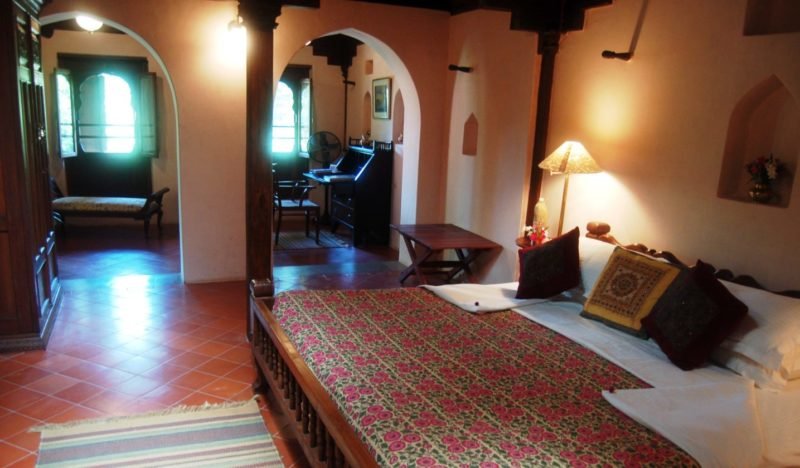
Best time to visit
Narmada Jayanti and Mahashivratri are two of the annual festivals that are celebrated with lots of passion in two towns of Omkareshwar and Maheshwar. During these seasons, they have their ghats adorned with lights and maha parties are performed at their ghats.
Best Places to see
- Ahalya Fort
The Ahalya Fort is named after Rajmata Ahilya Devi Holkar. She is one of the most legendary rulers of the region. She is considered a saintly figure.
This fort which is the best landmark of the town of Maheshwar still stands in all its splendor on banks of Narmada. There are some beautiful carvings of elephants and scenes of daily life from times of Holkar rule including some images of dancers and musicians.
A part of the Ahalya fort has now been converted into a hotel while another part is not open to the public. That said, you get to see Ahilya dwar where the great queen held a public audience – almost daily, and attended to the grievances of her subjects.
We also saw some amazing portraits of Holkar rulers, arms, etc. The male rulers are shown with a sword in their hand but the queen Ahilyabai is shown carrying a Shiva linga in her hands and is adorned with a simple white sari – a symbol of her widowhood. According to a local legend, the queen despite her immense wealth had only three sarees – all of them white, all of them Maheshwari and all of them woven by herself. This legend besides the simplicity of the palace itself, so different from lush ways of palaces elsewhere in India show what a simple life the queen must have lived.
One of the artifacts on display here is famous for the cravings is the Chhatri (mausoleum) of Vitoji Rao Holkar, who was the younger brother of king Yashwant Rao Holkar. The artifact is Built on a high plinth and supports two bulbous domes.
Another artifact that caught our eye is Ahilyeshwar Shivalaya. Built like a Shiva temple, it is the chhatri of the queen Ahilya Bai Holkar and was built on orders of her daughter Krishna Bai
There is a museum within Ahalya Fort. Another division is the weaving center of Rehwa society. You can find and buy the popular Maheshwari sarees here.
The name of the society comes from Maa Rewa, a local name of the Narmada river. Richard Holkar of the Holkar dynasty and his wife Sally started this weaving project in order to create employment opportunities for the local women and in order to save the dying industry of Maheshwari sarees which now, thanks to the efforts of the project, has now regained the old popularity. The weavers have now diversified into other forms of clothes too – dupattas, scarves, shawls, etc. A Maheshwari saree is thus obviously a perfect souvenir from the town of Maheshwar.
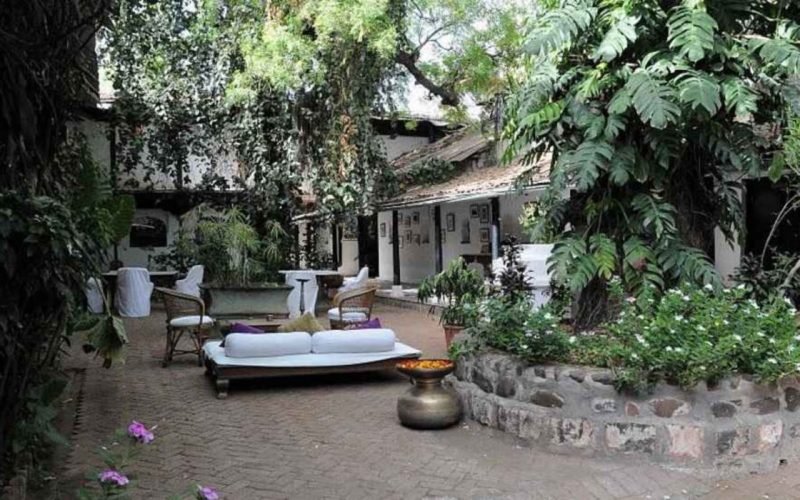
- Narmada Ghats
Maheshwar is home to twenty-eight ghats. The most important ones of these Ghats are Ahilya Ghat, Mahila Ghat, Peshwa Ghat, and Phanse Ghat. At Mahila Ghat, you will also get to see the artifact known as Laxmi Bai ki Chhatri – the chhatri of Ahilya Bais daughter, Krishna Bai
The Narmada river also avails you of boating adventures in its tranquil waters.
The Narmada river is itself the biggest attraction of both Maheshwar and Omkareshwar. Of the five most sacred rivers of India – Ganga, Yamuna, Narmada, Godavari, and Kaveri, Narmada has been considered the holiest. In fact, according to a local legend, when Ganga feels unclean, she takes the form of a black cow and arrives here under cover of darkness to cleanse herself in the waters of the Narmada. It is thus no wonder that countless pilgrimages pay a visit to the town to take a dip in the waters of the majestic river.
The Narmada river is also called Shankari which literally means the daughter of Shankar (Lord Shiva). According to a popular Hindu legend, she was borne out of a teardrop that fell out of Shiva’s eyes.

A local saying is Narmada ke kankar utte Shankar which means that Lord Shiva lives in each and every pebble on which the Narmada flows. This is particularly true in the case of river’s Ghats at Maheshwar as according to a local legend, it is believed to be the site ancient city of Somvanshya Shastrarjun Kshatriya. This ancient city was the capital of king Kartavirya Arjuna who is also known as Shree Shastrarjun and is mentioned in the Sanskrit epics Ramayana and Mahabharata. Shastraarjun is said to have given a humiliating defeat to Ravana according to a local legend. one day the King Sahasrarjun and his 500 wives were picnicking on banks of Narmada. When the wives wanted a vast play area, the King is said to have stopped the Narmada with his 1000 arms. Ravana, who was flying by in his Pushpak Vimana decided to worship Lord Shiva in the empty river beds and made a shivalinga out of the sand and began to pray. When Sahasrajuna’s wives were done playing, he let the waters flow which Ravanas shivalinga away. Angered by this, Ravana challenged Sahasrajuna who, accepting the challenge, gave him a humiliating defeat.
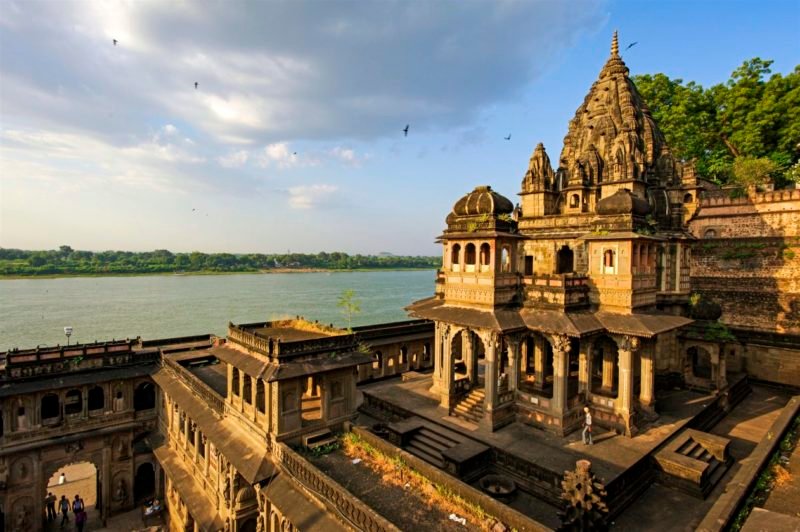
And at the banks of the river, you can still find cylindrical pebbles, locally called Banalingas because they look so much like shivalingas. These ballingas are worshipped across India and, if you have a Hindu religious frame of mind, they make perfect souvenirs.
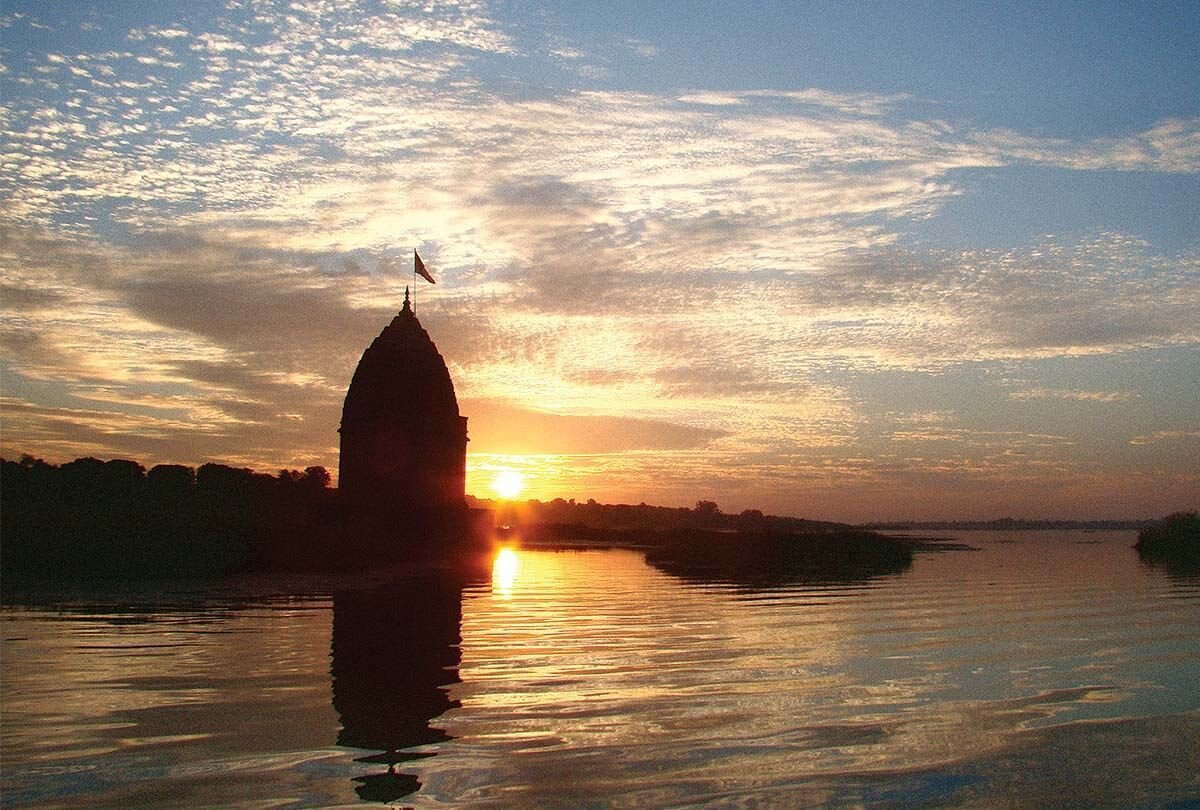
- Sahasradhara
Sahasradhara (the name literally means a thousand streams) is a place near Maheshwar where one can see the Narmada in all her majesty divide, as the name suggests, into thousands of tiny streams.


- Temples
There are, as we mentioned before, over a hundred temples in the town of Maheshwar – many of these are the results of the devotional nature of its legendary queen and, the city’s mythological importance is the reason behind the others.
Sahasarjun temple is one of the most important temples in the town.
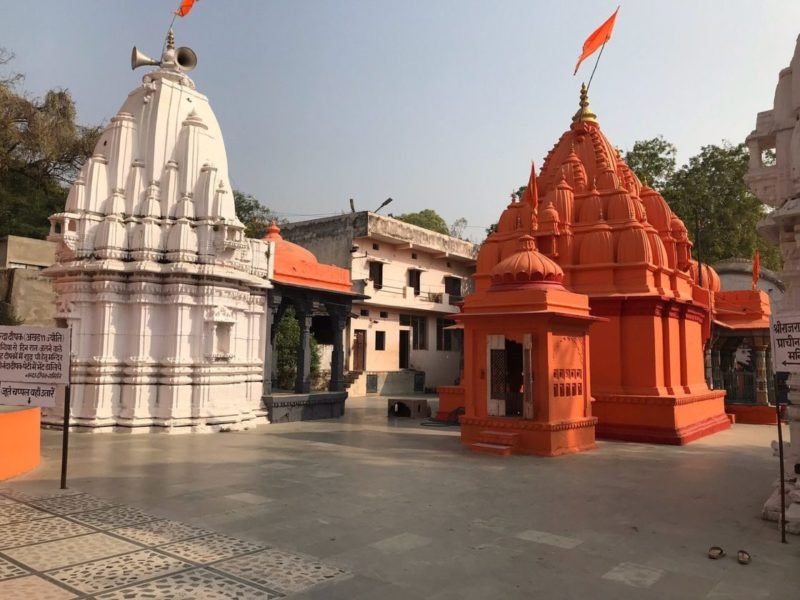
As per a legend contained in Sabha Parva in Andhra Mahabharata, a nishada king named Nila ruled over Mahishmati. His daughter was an amazing beauty. She and Agni, the God of fire, fell in love with each other. The princess would always stay near the sacred fire of her father, and her presence would blaze with vigor. It won’t blaze even if fanned unless it was agitated by the gentle and tender breath of her lips. Agni took the form of a Brahmana and started visiting her. The couple was caught, the angered king wanted to punish the Brahmin with death but when Agni revealed his true identity, King sought forgiveness. Agni agreed to forgive him and even swore to protect his kingdom on the condition that the great king should sanctify pleasure out of pure love a legitimate action in his kingdom, and thus liberate the kingdom of the custom of marriage – a rather feminist story for ancient times. Even to this date, Sahasrarjun temple lights 11 lamps in honor of Lord Agni blessing the Kingdom.
There is also an amazing Baneshwar Mahadev Temple. This temple, dedicated to Lord Shiva, is situated on an island in the middle of the Narmada. According to local mythical beliefs, a heavenly line – an axis of sorts from the North Star passes through the point of this temple to the earth’s very center.

Sapta Martuka Mandir is another important temple and boosts of seven shrines devoted to seven goddesse. This temple is located on a small ghat.
Some of the other temples include Bhawani Mata Mandir, Ram and Krishna Mandir, Rajrajeshwar Mandir, Chaturbhuj Narayan Mandir, Khedapati Hanuman, Kashi Vishwanath Mandir, Narsingh Mandir, Ganesh Mandir, Chintamani Ganpati Mandir, Pandharinath Mandir, , Banke Bihari, Anant Narayan Mandir etc.
What to buy at Maheshwar?
We have already mentioned how Ballingas are unique souvenirs only to be found in Maheshwar. Another souvenir that has made Maheshwar popular all over India is its Maheshwari sarees.
Maheshwari sarees, now regaining their old familiarity, are woven using conventional wooden looms and are traditionally colored using vegetable dyes which make the original quality of these sarees expensive. There are ones that use chemical dyes and are less costly but these we didn’t find that beautiful.


The popular colors for the Maheshwari Sarees include angoori (grape green), gul bakshi (magenta), dalimbi (deep pink), tapkeer (deep brown), jaamla (purple), aamras (golden-yellow), etc. The pallav or aanchal of these Maheshwari sarees have five stripes of two alternating colors – of which one is always white.

The zari and kinari are used to embellish the Maheshwari sarees which often have a rich golden border and two gold bands on the pallav. These sarees are characterized by reversible border making it possible to wear both sides. Suited to the hot climate of Madhya Pradesh, these sarees have a light cloth which, so to speak, floats on your body and thus make them perfect wear in Indian Summers.
Places Near Maheshwar worth visiting
Kaleshwar and Jwaleshwar mandirs are some important temples located just a little outside the town. Take in as many of these temples as you can before taking the bus to your next destination.
The chances are you will come here via Indore which is one of the best tourist attractions in itself and has several forts and attractions of its own – including the best variety of street food you will find in it.
We recommend combining your journey to Maheshwar with Omkareshwar which is only 3 hours journey away from Maheshwar and is an island of great spiritual importance among Hindus and offers beautiful sights that will be loved by tourists even if they are indifference to its spiritual importance.
We hope you have an amazing trip. 🙂




